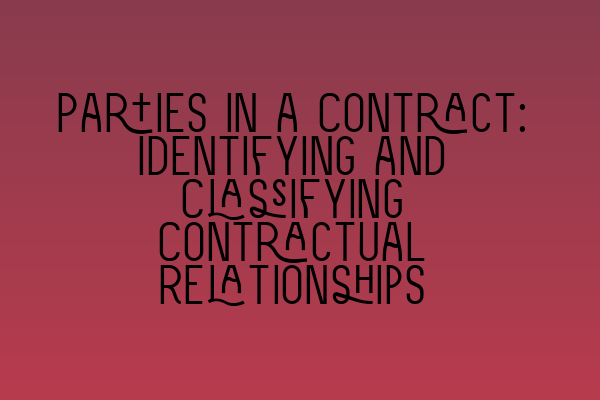Parties in a Contract: Identifying and Classifying Contractual Relationships
In contract law, identifying and classifying the parties involved in a contract is a crucial step in understanding the rights and obligations that arise from the agreement. Each party has a unique role and responsibility, and it is essential to have a clear understanding of these roles to ensure the enforceability and validity of the contract. In this article, we will discuss the different types of parties in a contract and provide insights into their legal significance.
1. The Offeror
The offeror is the party who initiates the contract by making an offer. This party is the one who proposes the terms and conditions of the agreement and indicates an intention to be bound by those terms. The offeror may be an individual, a company, or any other legal entity capable of entering into a contract. It is important for the offeror to clearly communicate the terms of the offer to the offeree.
2. The Offeree
The offeree is the party to whom the offer is made. They are the recipients of the offer and have the choice to accept or reject the terms proposed by the offeror. The offeree may also have the power to negotiate the terms of the contract before acceptance, depending on the circumstances. It is crucial for the offeree to communicate their acceptance or rejection in a clear and timely manner for the contract to be formed.
3. Intervening Third Parties
In some cases, there may be third parties who hold a legal interest or obligation in the contract, even though they are not the offeror or the offeree. These intervening third parties may include guarantors, sureties, or beneficiaries. It is important to consider the rights and obligations of these third parties when drafting and interpreting the contract.
4. Joint Obligors
Joint obligors are parties who share a joint obligation or liability under the contract. This means that each party is individually responsible for the fulfillment of the obligations outlined in the contract. If one party fails to perform their obligations, the other joint obligors may be held responsible for their share of the obligations. It is crucial to clearly define the rights and responsibilities of joint obligors in the contract.
5. Severally Liable Parties
Severally liable parties, on the other hand, are parties who have separate and individual obligations under the contract. Each party is responsible for fulfilling their own obligations, and the failure of one party does not affect the liability of the others. It is important to clearly identify severally liable parties in the contract to accurately determine their respective obligations.
6. Agents and Principals
In certain contractual relationships, one party may act as an agent on behalf of another party. The agent acts on behalf of the principal and has the authority to bind the principal in contractual obligations. It is important to establish the agency relationship and the extent of the agent’s authority in the contract to ensure the enforceability of the agreement.
Conclusion
Identifying and classifying the parties in a contract is essential for understanding the rights and obligations that arise from the agreement. Whether you are the offeror, offeree, joint obligor, severally liable party, or agent, it is important to clearly define your role and responsibilities in the contract to avoid ambiguity and disputes. By understanding the various types of parties involved in a contract, you can ensure that your contractual relationships are legally sound and enforceable.
Related Articles:
– SQE 1 Practice Exam Questions
– SQE 1 Practice Mocks FLK1 FLK2
– SQE 2 Preparation Courses
– SQE 1 Preparation Courses
– SRA SQE Exam Dates
